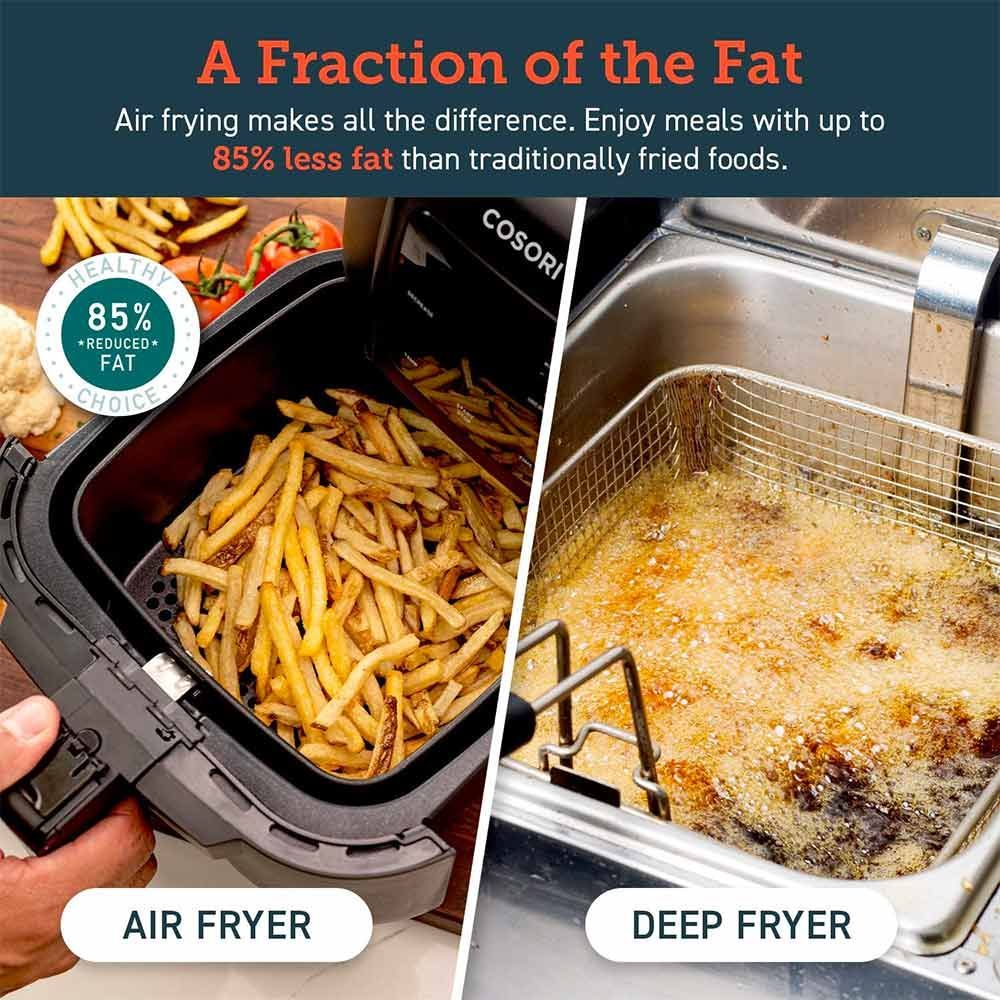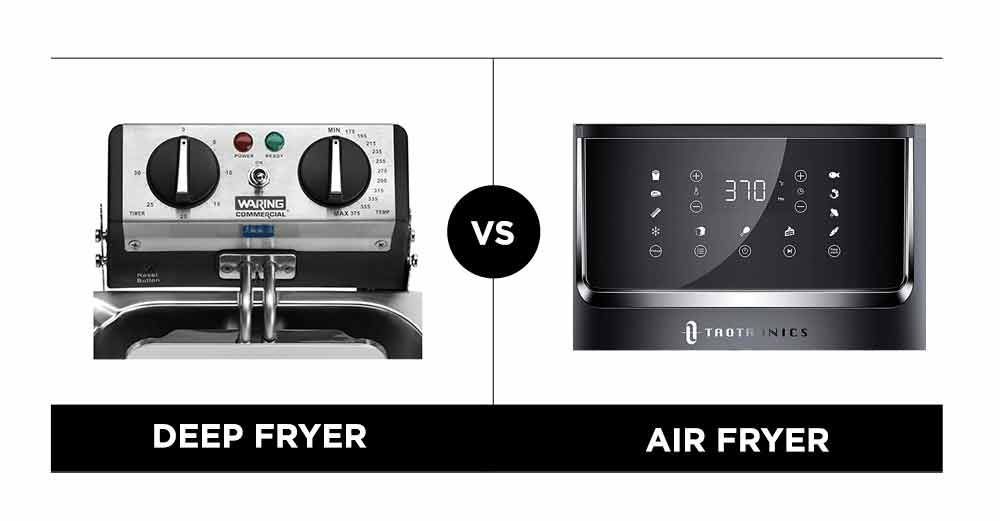Our recommendations are made independently. We may receive commissions from purchases made via our links.
Air Fryers vs. Deep Fryers: Differences, Pros & Cons, & Conversion Guide
Follow our article, and you will find all the important information regarding the differences between air fryers vs. deep fryers.
Both air fryers and deep fryers are developed to help you prepare fried food with ease. While they are not the only appliances that can give you all the flavor of fried food, they are likely to be the best choices, given their improvements in efficiency, versatility, and safety.
However, it’s obvious that despite these innovative kitchen appliances sharing the same goal, they work in different manners. They cannot be used interchangeably and of course, each appliance has its own strengths and shortcomings.
That’s why in this article, we highlight some of the important differences between air fryers and deep fryers. Hopefully you will get a clear picture of which appliance you’ll need along the way.
Difference Between Air Fryers vs. Deep Fryers
Below you can find some valuable information regarding some specific features of air fryers and deep fryers:
Function
From the get-go, the names themselves are indicators of how they are different in terms of function.
Air fryers work similarly to convection ovens, using built-in fans and heating elements on top of the cavity to circulate heat around the food.
Deep fryers, on the other hand, require the food to be fully submerged in a large amount of hot oil. That way, their heating elements which are powered by either electric or natural gas can ensure even heat distribution.
Depending on your needs and demands, you can choose between an air fryer and a deep fryer, or buy both.
Since air-fried food aims to have a similar flavor and texture to deep-fried food, your taste buds will tell you that it tastes like extra-crispy oven-baked food.
Rather than being shatteringly crispy on the outside, with a perfect golden brown finish, air-fried food often browns unevenly or ends up overly dry underneath. It also doesn’t stay crisp as long as its counterpart.
With the lower content of fat and calories, however, air fried food is guilt-free. Even though it cannot provide you with the crunchy, melt-in-your-mouth sensation of traditional deep fried foods, it makes for a healthier eating experience.

Temperature Controls
Temperature controls matter, because without them, you’ll need to keep your eyes on the frying process constantly to ensure safety and optimal results.
Since most fried food recipes call for high heat, both air fryers and deep fryers are designed with adjustable temperature controls varying from 120°F to at least 375°F. This range is wide enough to handle the appropriate frying temperatures for different foods.
However, not all deep fryers are capable of maintaining the proper temperature during the cooking process. Some leave your food burnt on the outside and undercooked on the inside, as a result of overheating the cooking oil.
Alternatively, the temperature could drop too low when you add food to the frying basket, and fail to heat up quickly enough to prevent the food from retaining too much moisture and emerging soggy.
For optimal results, even when your deep fryer is equipped with temperature control, use a separate thermometer to make sure the machine is always at a minimum operating temperature.
Regarding air fryers, the wider range of temperature controls makes the machine more versatile, allowing you to enjoy a greater variety of cooking styles. Like deep fryers, if your air fryer cannot keep the frying temperature steady at the chosen level, there is no way that you can enjoy the satisfaction of biting into a crunchy, golden brown French fry.
There is an assumption that fryers with the ability to achieve higher temperatures will heat up faster and brown foods more easily. As a matter of fact, how fast and how well the food is cooked depends on a number of factors.
These include the machine’s power, the size of the food portion, and its water content, as well as the efficiency of the heating elements and built-in fans.

Versatility
Since air fryers are basically smaller versions of convection ovens, they can do almost everything that a standard oven can do. They’re multifunctional cookers that let you bake, roast, broil, grill, or even dehydrate food conveniently and safely
Depending on the model, some air fryers are equipped with pre-programmable cooking options, letting you cook with the touch of a button. Taking the guesswork out of the cooking times and temperatures, these standalone appliances are convenient to use, but often not so expensive.
Typically, your air fryer can work with several cooking accessories. Pizza pans, multi-purpose racks, or silicone cupcake pans are common attachments that can either come included or be bought at an inexpensive price. Having more stuff helps you get the most out of your fryer, but this also means that you may struggle to store them all neatly.
Not as versatile as their counterparts, deep fryers are only used to fry food. But when it comes to preparing perfect crispy delights, especially those coated with layers of wet batter, nothing can cook it better than a reliable deep fryer.
Because air fryers can’t cook the wet batter fast enough to prevent it from dripping through the perforated basket, your batter-fried food will not end up with a crisp crust.
Most deep fryers have dial controls. There are also fryers that come with digital controls to offer you extra convenience, though they are not common. Besides allowing you to manually set the time and temperature, digital control machines also give you the best settings for some of your favorite fried dishes, thanks to their built-in cooking pre-sets.
Deep fryer accessories are also available, but not really necessary. Apart from a thermometer, cleaning solutions and soft-bristled brushes are required to ensure the good working condition of your fryer.
And since using a deep fryer to cook food involves a lot of cooking oil, you’ll need to buy a handy filter to deal with used oil after each fry.
Size and Capacity
The most popular type of air fryer is usually around 4 quarts, which means it can fit easily in almost any kitchen. Compact yet powerful, this portable gadget should easily feed a family of 3-4 people.
There are also larger and smaller sized models. At between 5 and 8 quarts capacity, larger ones are better suited for those who have bigger kitchens or who often cook for a crowd and routinely host dinner parties.
For restricted kitchens, RVs, and single dorms, smaller-sized air fryers with capacity varying between 1.7 and 2.7 quarts usually fit better. With limited frying baskets, however, they only offer enough cooking space for 1 pound of French fries, a 1.5-pound rotisserie chicken, or 2-3 slices of toast.
Coming in quite a range of sizes and designs, deep fryers usually have a capacity ranging from 2 quarts to nearly 24 quarts. However even if they have the same capacity, the usable cooking space of air fryers and deep fryers are not equivalent.
With cramped interiors, air fryers cannot distribute heat around the food evenly unless you avoid filling it to capacity. If you stack food closer together in an air fryer, their sides will be flush with one another, preventing the heat from circulating evenly around each item.
For example, with the largest pod-shaped air fryer, you will only prepare a maximum of 4-5 servings of one kind of food, while a deep fryer featuring the same capacity may let you cook a larger quantity of different types of food at the same time.
A Comparison Chart
Here’s a table that shows the basic distinctions between these two appliances more easily.
| Air Fryer | Deep Fryer |
|---|---|---|
Function | Fry, grill, bake, roast, broil, defrost, reheat, dehydrate | Deep fry only |
Oil used | Large amounts | Little to zero |
Capacity | 1.7 - 8 quarts | 2.0 - 24 quarts |
Temperature | 120°F - 400°F | 120°F - 400°F |
Cooking time | Slower | Faster |
Price | $35 - $300 | $245 - $300 |
Safety | High | Lower |
Ease of Cleaning | High | Medium |
Durability | Medium | Medium |
Air Fryers vs. Deep Fryers: Which One is Better?
Those are some of the differences between air fryer vs. deep fryers. In conclusion, deciding which appliance is better will mainly depend on your needs and lifestyle.
Top-rated air fryers would be appealing countertop appliances for those who plan on sticking to a healthy diet but cannot deprive themselves of the foods they love.
These appliances perform well in their jobs, producing French fries, onion rings, chicken wings, and any other fried food in no time at all. Although food cooked in an air fryer may not be as crispy on the outside and juicy on the inside as what you get from deep fryers, they will help you achieve a more balanced diet.
Moreover, despite the smaller frying baskets, air fryers do come with countless capabilities. Whether the task at hand is reheating, grilling, baking, or even roasting, an all-in-one air fryer can complete it all. It even serves as a dehydrator that can remove bacteria-forming moisture to help you preserve food for much longer.
On the other hand, while costing as much as their counterparts, deep fryers are single-use appliances that perform only one specific task. But if it’s crispier, tender-fried food that you’re starving, then they make for a great option.Unless you consume 2-3 serving of fried food per week, however, your deep fryer is likely to do little more than take up counter space in the kitchen . It’s even a waste of money compared to a stock pot — an appliance that can accomplish many other tasks while being easily stored in a drawer or a hanging rail.

